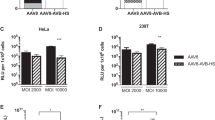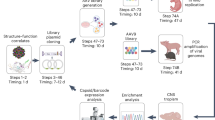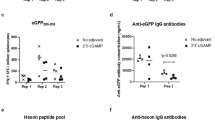Abstract
Adenovirus (Ad) vectors are of utility for many therapeutic applications. Strategies have been developed to alter adenoviral tropism to achieve a cell-specific gene delivery capacity employing fiber modifications allowing genetic incorporation of targeting motifs. In this regard, single chain antibodies (scFv) represent potentially useful agents to achieve targeted gene transfer. However, the distinct biosynthetic pathways that scFv and Ad capsid proteins are normally routed through have thus far been problematic with respect to scFv incorporation into the Ad capsid. Utilization of stable scFv, which also maintain correct folding and thus functionality under intracellular reducing conditions, could overcome this restriction. We genetically incorporated a stable scFv into a de-knobbed, fibritin-foldon trimerized Ad fiber and demonstrated selective targeting to the cognate epitope expressed on the membrane surface of cells. We have shown that the scFv employed in this study retains functionality and that stabilizing the targeting molecule, per se, is critical to allow retention of antigen recognition in the adenovirus capsid-incorporated context.
This is a preview of subscription content, access via your institution
Access options
Subscribe to this journal
Receive 12 print issues and online access
$259.00 per year
only $21.58 per issue
Buy this article
- Purchase on Springer Link
- Instant access to full article PDF
Prices may be subject to local taxes which are calculated during checkout




Similar content being viewed by others
References
Ager S, Nilson BH, Morling FJ, Peng KW, Cosset FL, Russell SJ . Retroviral display of antibody fragments; interdomain spacing strongly influences vector infectivity. Hum Gene Ther 1996; 7: 2157–2164.
Konishi H, Ochiya T, Chester KA, Begent RH, Muto T, Sugimura T et al. Targeting strategy for gene delivery to carcinoembryonic antigen-producing cancer cells by retrovirus displaying a single-chain variable fragment antibody. Hum Gene Ther 1998; 9: 235–248.
Martin F, Neil S, Kupsch J, Maurice M, Cosset F, Collins M . Retrovirus targeting by tropism restriction to melanoma cells. J Virol 1999; 73: 6923–6929.
Hammond AL, Plemper RK, Zhang J, Schneider U, Russell SJ, Cattaneo R . Single-chain antibody displayed on a recombinant measles virus confers entry through the tumor-associated carcinoembryonic antigen. J Virol 2001; 75: 2087–2096.
Karavanas G, Marin M, Bachrach E, Papavassiliou AG, Piechaczyk M . The insertion of an anti-MHC I ScFv into the N-terminus of an ecotropic MLV glycoprotein does not alter its fusiogenic potential on murine cells. Virus Res 2002; 83: 57–69.
Bucheit AD, Kumar S, Grote DM, Lin Y, von Messling V, Cattaneo RB et al. An oncolytic measles virus engineered to enter cells through the CD20 antigen. Mol Ther 2003; 7: 62–72.
Nguyen TH, Loux N, Dagher I, Vons C, Carey K, Briand P et al. Improved gene transfer selectivity to hepatocarcinoma cells by retrovirus vector displaying single-chain variable fragment antibody against c-Met. Cancer Gene Ther 2003; 10: 840–849.
Peng KW, Donovan KA, Schneider U, Cattaneo R, Lust JA, Russell SJ . Oncolytic measles viruses displaying a single-chain antibody against CD38, a myeloma cell marker. Blood 2003; 101: 2557–2562.
Chowdhury S, Chester KA, Bridgewater J, Collins MK, Martin F . Efficient retroviral vector targeting of carcinoembryonic antigen-positive tumors. Mol Ther 2004; 9: 85–92.
Kuroki M . Gene therapy in cancer via use of a retrovector having a tumor specificity and expressing inducible nitric oxide synthase. Methods Mol Biol 2004; 279: 201–211.
Magnusson MK, Hong SS, Henning P, Boulanger P, Lindholm L . Genetic retargeting of adenovirus vectors: functionality of targeting ligands and their influence on virus viability. J Gene Med 2002; 4: 356–370.
Douglas JT, Rogers BE, Rosenfeld ME, Michael SI, Feng M, Curiel DT . Targeted gene delivery by tropism-modified adenoviral vectors. Nat Biotechnol 1996; 14: 1574–1578.
Goldman CK, Rogers BE, Douglas JT, Sosnowski BA, Ying W, Siegal GP et al. Targeted gene delivery to Kaposi's sarcoma cells via the fibroblast growth factor receptor. Cancer Res 1997; 57: 1447–1451.
Haisma HJ, Pinedo HM, Rijswijk A, der Meulen-Muileman I, Sosnowski BA, Ying W et al. Tumor-specific gene transfer via an adenoviral vector targeted to the pan-carcinoma antigen EpCAM. Gene Therapy 1999; 6: 1469–1474.
Tillman BW, de Gruijl TD, Luykx-de Bakker SA, Scheper RJ, Pinedo HM, Curiel TJ et al. Maturation of dendritic cells accompanies high-efficiency gene transfer by a CD40-targeted adenoviral vector. J Immunol 1999; 162: 6378–6383.
Dmitriev I, Kashentseva E, Rogers BE, Krasnykh V, Curiel DT . Ectodomain of coxsackievirus and adenovirus receptor genetically fused to epidermal growth factor mediates adenovirus targeting to epidermal growth factor receptor-positive cells. J Virol 2000; 74: 6875–6884.
Reynolds PN, Zinn KR, Gavrilyuk VD, Balyasnikova IV, Rogers BE, Buchsbaum DJ et al. A targetable, injectable adenoviral vector for selective gene delivery to pulmonary endothelium in vivo. Mol Ther 2000; 2: 562–578.
Kashentseva EA, Seki T, Curiel DT, Dmitriev IP . Adenovirus targeting to c-erbB-2 oncoprotein by single-chain antibody fused to trimeric form of adenovirus receptor ectodomain. Cancer Res 2002; 62: 609–616.
Barberis A, Auf der Maur A, Tissot K, Lichtlen P . Intrabodies: development and application in functional genomics and therapy. In: Subramanian G (ed.), Antibodies: Novel Technologies and Therapeutic Use. London: Springer-Verlag, 2004.
Stocks MR . Intrabodies: production and promise. Drug Discov Today 2004; 9: 960–966.
Graff CP, Chester K, Begent R, Wittrup KD . Directed evolution of an anti-carcinoembryonic antigen scFv with a 4-day monovalent dissociation half-time at 37 degrees C. Protein Eng Des Sel 2004; 17: 293–304.
Auf der Maur A, Escher D, Barberis A . Antigen-independent selection of stable intracellular single-chain antibodies. FEBS Lett 2001; 508: 407–412.
Auf der Maur A, Zahnd C, Fischer F, Spinelli S, Honegger A, Cambillau C et al. Direct in vivo screening of intrabody libraries constructed on a highly stable single-chain framework. J Biol Chem 2002; 277: 45075–45085.
Auf der Maur A, Tissot K, Barberis A . Antigen-independent selection of intracellular stable antibody frameworks. Methods 2004; 34: 215–224.
Einfeld DA, Brough DE, Roelvink PW, Kovesdi I, Wickham TJ . Construction of a pseudoreceptor that mediates transduction by adenoviruses expressing a ligand in fiber or penton base. J Virol 1999; 73: 9130–9136.
Vigne E, Mahfouz I, Dedieu JF, Brie A, Perricaudet M, Yeh P . RGD inclusion in the hexon monomer provides adenovirus type 5-based vectors with a fiber knob-independent pathway for infection. J Virol 1999; 73: 5156–5161.
Wu H, Han T, Belousova N, Krasnykh V, Kashentseva E, Dmitriev I et al. Identification of sites in adenovirus hexon for foreign peptide incorporation. J Virol 2005; 79: 3382–3390.
Dmitriev I, Krasnykh V, Miller CR, Wang M, Kashentseva E, Mikheeva G et al. An adenovirus vector with genetically modified fibers demonstrates expanded tropism via utilization of a coxsackievirus and adenovirus receptor-independent cell entry mechanism. J Virol 1998; 72: 9706–9713.
Krasnykh V, Dmitriev I, Mikheeva G, Miller CR, Belousova N, Curiel DT . Characterization of an adenovirus vector containing a heterologous peptide epitope in the HI loop of the fiber knob. J Virol 1998; 72: 1844–1852.
Xia H, Anderson B, Mao Q, Davidson BL . Recombinant human adenovirus: targeting to the human transferrin receptor improves gene transfer to brain microcapillary endothelium. J Virol 2000; 74: 11359–11366.
Mizuguchi H, Koizumi N, Hosono T, Utoguchi N, Watanabe Y, Kay MA et al. A simplified system for constructing recombinant adenoviral vectors containing heterologous peptides in the HI loop of their fiber knob. Gene Therapy 2001; 8: 730–735.
Nicklin SA, Von Seggern DJ, Work LM, Pek DC, Dominiczak AF, Nemerow GR et al. Ablating adenovirus type 5 fiber-CAR binding and HI loop insertion of the SIGYPLP peptide generate an endothelial cell-selective adenovirus. Mol Ther 2001; 4: 534–542.
Belousova N, Krendelchtchikova V, Curiel DT, Krasnykh V . Modulation of adenovirus vector tropism via incorporation of polypeptide ligands into the fiber protein. J Virol 2002; 76: 8621–8631.
Wickham TJ, Roelvink PW, Brough DE, Kovesdi I . Adenovirus targeted to heparan-containing receptors increases its gene delivery efficiency to multiple cell types. Nat Biotechnol 1996; 14: 1570–1573.
Wickham TJ, Tzeng E, Shears LL, Roelvink PW, Li Y, Lee GM et al. Increased in vitro and in vivo gene transfer by adenovirus vectors containing chimeric fiber proteins. J Virol 1997; 71: 8221–8229.
van Beusechem VW, van Rijswijk AL, van Es HH, Haisma HJ, Pinedo HM, Gerritsen WR . Recombinant adenovirus vectors with knobless fibers for targeted gene transfer. Gene Therapy 2000; 7: 1940–1946.
Magnusson MK, Hong SS, Boulanger P, Lindholm L . Genetic retargeting of adenovirus: novel strategy employing ‘deknobbing’ of the fiber. J Virol 2001; 75: 7280–7289.
Mercier GT, Campbell JA, Chappell JD, Stehle T, Dermody TS, Barry MA . A chimeric adenovirus vector encoding reovirus attachment protein sigma 1 targets cells expressing junctional adhesion molecule 1. Proc Natl Acad Sci USA 2004; 101: 6188–6193.
Krasnykh V, Belousova N, Korokhov N, Mikheeva G, Curiel DT . Genetic targeting of an adenovirus vector via replacement of the fiber protein with the phage T4 fibritin. J Virol 2001; 75: 4176–4183.
Belousova N, Korokhov N, Krendelshchikova V, Simonenko V, Mikheeva G, Triozzi PL et al. Genetically targeted adenovirus vector directed to CD40-expressing cells. J Virol 2003; 77: 11367–11377.
Henning P, Andersson KM, Frykholm K, Ali A, Magnussion MK, Nygren PA et al. Tumor cell targeted gene delivery by adenovirus 5 vectors carrying knobless fibers with antibody-binding domains. Gene Therapy 2005; 12: 211–224.
Noureddini SC, Krendelshchikov A, Simonenko V, Hedley SJ, Douglas JT, Curiel DT et al. Generation and selection of targeted adenoviruses embodying optimized vector properties. J Mol Biol 2005, submitted.
Korokhov N, Mikheeva G, Krendelshchikov A, Belousova N, Simonenko V, Krendelshchikova A et al. Targeting of adenovirus via genetic modification of the viral capsid combined with a protein bridge. J Virol 2003; 77: 12931–12940.
Von Seggern DJ, Kehler J, Endo RI, Nemerow GR . Complementation of a fibre mutant adenovirus by packaging cell lines stably expressing the adenovirus type 5 fibre protein. J Gen Virol 1998; 79 (Part 6): 1461–1468.
Acknowledgements
We thank Wesam Noureddini for helpful discussion and support. This work was funded in part by the Muscular Dystrophy Association Inc., (MDA), Department of Defense, Contract W81XWH-05-1-0035 and NIH Grant 1P01HL076540. Dr Alcide Barberis and ESBATech AG were supported in part by the Commission of Technology and Innovation (CTI) of the Swiss Government.
Author information
Authors and Affiliations
Corresponding author
Rights and permissions
About this article
Cite this article
Hedley, S., Auf der Maur, A., Hohn, S. et al. An adenovirus vector with a chimeric fiber incorporating stabilized single chain antibody achieves targeted gene delivery. Gene Ther 13, 88–94 (2006). https://doi.org/10.1038/sj.gt.3302603
Received:
Revised:
Accepted:
Published:
Issue Date:
DOI: https://doi.org/10.1038/sj.gt.3302603
Keywords
This article is cited by
-
A Dendritic Cell-Targeted Adenoviral Vector Facilitates Adaptive Immune Response Against Human Glioma Antigen (CMV-IE) and Prolongs Survival in a Human Glioma Tumor Model
Neurotherapeutics (2018)
-
Engineered adenovirus fiber shaft fusion homotrimer of soluble TRAIL with enhanced stability and antitumor activity
Cell Death & Disease (2016)
-
A novel single-chain antibody redirects adenovirus to IL13Rα2-expressing brain tumors
Scientific Reports (2015)
-
Adenoviral targeting using genetically incorporated camelid single variable domains
Laboratory Investigation (2014)
-
Engineered retroviral virus-like particles for receptor targeting
Archives of Virology (2014)



